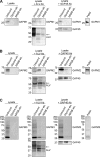A novel family of Apicomplexan glideosome-associated proteins with an inner membrane-anchoring role
- PMID: 19561073
- PMCID: PMC2757237
- DOI: 10.1074/jbc.M109.036772
A novel family of Apicomplexan glideosome-associated proteins with an inner membrane-anchoring role
Abstract
The phylum Apicomplexa are a group of obligate intracellular parasites responsible for a wide range of important diseases. Central to the lifecycle of these unicellular parasites is their ability to migrate through animal tissue and invade target host cells. Apicomplexan movement is generated by a unique system of gliding motility in which substrate adhesins and invasion-related proteins are pulled across the plasma membrane by an underlying actin-myosin motor. The myosins of this motor are inserted into a dual membrane layer called the inner membrane complex (IMC) that is sandwiched between the plasma membrane and an underlying cytoskeletal basket. Central to our understanding of gliding motility is the characterization of proteins residing within the IMC, but to date only a few proteins are known. We report here a novel family of six-pass transmembrane proteins, termed the GAPM family, which are highly conserved and specific to Apicomplexa. In Plasmodium falciparum and Toxoplasma gondii the GAPMs localize to the IMC where they form highly SDS-resistant oligomeric complexes. The GAPMs co-purify with the cytoskeletal alveolin proteins and also to some degree with the actin-myosin motor itself. Hence, these proteins are strong candidates for an IMC-anchoring role, either directly or indirectly tethering the motor to the cytoskeleton.
Figures






References
Publication types
MeSH terms
Substances
Grants and funding
LinkOut - more resources
Full Text Sources
Molecular Biology Databases

